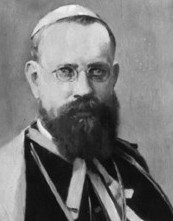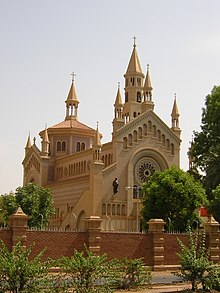Roman Catholic Church in Sudan
The Roman Catholic Church in Sudan and South Sudan is part of the worldwide Roman Catholic Church .
History and mission


Christianity established itself in Sudan in the 5th / 6th centuries. Century, when three Christian kingdoms existed in Nubia . However, it was pushed back by the spread of Islam from 640 onwards, but a non-aggression and trade agreement ("Baqt") regulated coexistence into the High Middle Ages. The Catholic Church was not rebuilt until the 19th century.
In 1842 the first Catholic school and mission in Khartoum was established by Fr. L. Montuori, a Vincentian priest .
Already in 1846 Pope Gregory XVI. the Apostolic Vicariate Sudan or Central Africa was established, which then stretched from the Atlantic to the Red Sea, until 1868 the western part, as the Apostolic Vicariate Sahara, was separated from it. The seat of the Mission and the Vicar Apostolic was Khartoum . Great service it acquired Austria-Hungary , because significant missionaries came from there and Emperor Franz-Joseph took over the patronage and support for the work of forces. By 1861 the mission claimed forty lives due to the climate and hardship, so that it almost came to a standstill.
It is thanks to the (meanwhile canonized) Italian world priest Daniele Comboni , who worked as a missionary in Khartoum, to revive the mission. Comboni was born as an Austrian citizen. In 1867 he founded a missionary seminar in Verona , from which the Congregation of the Comboni Missionaries , the "Sons of the Sacred Heart of Jesus" (FSCJ) named after him , also called the "African Missions of Verona" emerged. In 1876, Comboni also established a community of sisters of the “pious mothers of the negro countries” (Pie madri della Negrizia). In 1872 Comboni became Provikar and in 1877 first Apostolic Vicar of the mission area now only encompassing the actual Sudan . He died on October 10, 1881 in Khartoum, only 50 years old and no longer had to experience the destruction of the entire mission by the Mahdi uprising since 1882.
In Shiite dogmatics, the Mahdi - that is, “the one guided (by God)” - is the resurrected Imam of the end times; according to the Sunni view, the Mahdi is the restorer of the pure Islamic faith. Since 1881/82, the year 1300 according to the Islamic calendar, a Muhammad Ahmad posed himself as a Mahdi in Sudan and he succeeded in driving out the English and conquering Khartoum in 1885, whereby the English general Charles George Gordon was killed in defense of the city.
At the time of the Mahdi uprising from 1881 to 1899, all Catholic activities were forbidden and the active members of the Church had either fled or imprisoned. It was not until 1898 that Lord Kitchener succeeded in defeating Muhammad Ahmad's successor, the Bakkara-Sudanese Abd Allah , at Omdurman . Sudan had been an Anglo-Egyptian condominium since 1899 . The contract was renewed in 1936 and ended in 1956 with the independence of Sudan. After the establishment of the Anglo-Egyptian Sudan, Catholic activities could be resumed.
The second structure of the mission is due to the Apostolic Vicar Antonio Roveggio (1858-1902), from 1895 to 1902 Apostolic Vicar in Khartoum and Franz Xaver Geyer (1859-1943) who held the same office from 1903 to 1922. Since the colonial administration did not allow any missionary activity in the Islamic north, this only took place in the south. The large area of the former Apostolic Vicariate Sudan has been subdivided several times since 1913. First the Apostolic Vicariates Khartoum and Bahr el-Ghazal were created, later also the Apostolic Vicariates of Rumbek , Juba and Wau and the Apostolic Prefectures of Mupoi and Malakal .
In 1974 Sudan was the last country in Africa to have a church hierarchy with dioceses . Today Sudan includes the ecclesiastical province of Khartoum and South Sudan the ecclesiastical province of Juba .
Current situation
During the time of the Second Sudanese Civil War , the dioceses were among the few reliable contacts for aid organizations. Schools, hospitals and social centers were built with church help, which are currently still run by the dioceses. Since the end of the civil war, the Sudanese Bishops' Conference has been critically accompanying the peace and independence process in South Sudan and advocating reconciliation within South Sudan. The joint pastoral letters , which usually deal with social issues and are published after the meetings of the bishops' conference, as well as the Catholic radio stations that are grouped together to form the “Catholic Radio Network” (CRN) play an important role .
Before the independence referendum in South Sudan in 2011, many bishops took the view that the de facto separation of the country should lead to the independence of South Sudan. The Bishops 'Conference, however, did not separate the country in its structures: It still exists as a joint "Sudan Catholic Bishop Conference" (SCBC-SSS), but there is a secretariat of the "Sudan Catholic Bishops' Regional Conference" (SCBRC) in Juba, which represents the South Sudanese dioceses.
The pastoral situation is difficult. The dioceses have few priests; the parishes are usually organized over a large area. Even if many residents of the country describe themselves as Christians and Catholics and take part in the (verbal) worship services, due to the pastoral situation only a few can take part in the sacramental life. Church life in the country takes place in local congregations (“Chapels”), each of which is led by volunteer catechists. The foundation of small Christian communities , suggested by the bishops, is only partially successful because of the unstable situation and migration movements in the country. The Jesuits in Khartoum, Juba, Rumbek and Wau, as well as traditionally above all the Comboni missionaries in Khartoum and with 11 stations in South Sudan are present at international religious orders . In addition to pastoral care and missionary work, both religious orders also operate schools and vocational institutions.
structure
The Roman Catholic Church in Sudan has an ecclesiastical province and a total of two dioceses .
The Roman Catholic Church in South Sudan has an ecclesiastical province and a total of seven dioceses.
-
Archdiocese of Juba (8)
- Diocese of Malakal (5)
- Diocese of Rumbik (4)
- Diocese of Tambura-Yambio (6)
- Diocese of Torit (9)
- Diocese of Wau (3)
- Yei Diocese (7)
Geographically and politically includes the ecclesiastical province of Khartoum North Sudan and the ecclesiastical province of Juba to South Sudan . The strikingly stronger structure of the southern Sudanese church province of Juba is due to the relatively high number of Catholics there. In contrast to the northern Sudanese church province of Khartoum, where the proportion of Catholics in the total population is far below 10% and there are only 2 dioceses that cover the whole of northern Sudan with their large area.
In September 2008, the Catholic University of South Sudan was founded , based in Juba .
statistics
Status: 2004
- population
About 4,019,000 Catholics live in Sudan, making up 9.13% of the total population of Sudan. While the proportion of Catholics in North Sudan (Church Province Khartoum) is 3.5%, in South Sudan (Church Province Juba) 21.5% of the population are Roman Catholics. The Catholics also make up the largest proportion of Christians in Sudan (approx. 65%).
- Clergy
18 bishops (2 of them emeritus), 169 secular and 95 religious priests and 4 permanent deacons take care of the faithful .
There are 510 religious without ordination (167 men, 343 women).
Institutions
- Apostolic Nunciature Sudan
The Apostolic Nunciature in Sudan is based in Khartoum.
Apostolic Nuncio has been Archbishop Luís Miguel Muñoz Cárdaba since March 2020 .
- Sudanese Bishops' Conference
There is the Sudanese Bishops' Conference, which has its seat in Khartoum. The President of the Episcopal Conference is currently the Archbishop of Juba, Paolino Lukudu Loro . The Sudanese Bishops 'Conference is also a member of the Association of East African Bishops' Conferences .
Church buildings
In most dioceses there are only a few parishes that have their own fixed church building. Instead, these congregations set up church-like houses of prayer. The following larger churches and cathedrals exist in the respective Sudanese dioceses:
- Archdiocese of Khartoum : St. Matthew's Cathedral , St. Peter and Paul, St. Joseph
- Archdiocese of Juba : Cathedral of St. Teresa in Juba-Kator
- Diocese of al-Ubayyid : Cathedral of al-Ubayyid
- Diocese of Wau : Cathedral of Wau, St. Josef
cartridge
- St. Daniele Comboni , Bishop
- St. Josephine Bakhita , religious sister
See also
Web links
Individual evidence
- ↑ Martin Fitzenreiter: History, Religion and Monuments of the Islamic Period in Northern Sudan . In: Communications from the Sudan Archaeological Society in Berlin . tape 6 , 1997, pp. 37–50 ( sag-online.de [PDF; accessed on February 25, 2020] text of the Baqt contract on p. 39).
- ↑ On the current situation of the Church in South Sudan, cf. Bernhard Knorn: A country at a crossroads. Sudan and the January 9 referendum . In: Herder correspondence . tape 65 , no. 1 , 2011, ISSN 0018-0645 , p. 35-40 .
- ↑ See e.g. B. Catholic bishops of the Republic of South Sudan: Pastoral Message of Hope and Encouragement. (No longer available online.) November 5, 2013, archived from the original on December 2, 2013 ; accessed on November 25, 2013 . Info: The archive link was inserted automatically and has not yet been checked. Please check the original and archive link according to the instructions and then remove this notice.
- ^ Sudan Catholic Radio Network. Retrieved November 25, 2013 .
- ^ The challenge of having one Conference for both Sudan and South Sudan. AMECEA Social Communications, October 11, 2013, accessed November 25, 2013 .
- ^ Sudan Catholic Bishops' Regional Conference. Retrieved November 25, 2013 .
- ^ Patricia Lefevere: Catholic university launches in Sudan. National Catholic Reporter, November 11, 2010, accessed November 25, 2013 .


